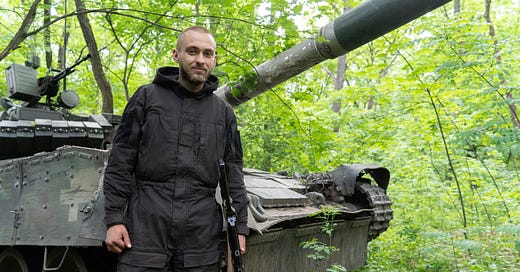Greetings from the Donbas! Since things have been very hectic and tiring this past week, I am going to keep this update short. Forgive me if it is not my most polished work. I am currently in a safe place, with trusted colleagues and a gassed-up car to take me somewhere else should this town become not so safe. If you have not already done so, I invite you to read my article in the Sunday Post this week about a mayor in a town smack in front of the Russian advance stretching from Izium.
The past week has not been kind to Ukraine in the Donbas. While the big prize of Severodonetsk remains in Ukrainian hands, the city of Lyman is now under partial Russian control while Bakhmut to the southeast is increasingly threatened. Russian firepower, for now, is proving to be overwhelming (although not yet to the point of deciding the battle).
When the Battle of Donbas started in earnest on April 18, the map looked like this:
As we can see, Luhansk Oblast was already mostly under Russian control, while Ukraine’s coastline on the Sea of Azov was entirely occupied by Moscow (save for pockets of resistance in Mariupol, which has since ceased).
Today, it looks like this:
Russia’s initial plan of encircling the entirety of central Donbas into a caldron has failed. This was thanks in no small part to Ukraine’s wins in the Kharkiv region, which seriously undermined Russia’s ability to form a southern axis stretching past Izium. The caldron thus has no lid. Russia is instead seeking to carve out little bubbles within the otherwise open caldron.


The most crucial objective is Severodonetsk, which has been the administrative center of Luhansk Oblast since the region’s capital of the same namesake came under Russian control in 2014. It is here that we are experiencing the war’s current epicenter as Russia fights to expel Ukrainian forces from the city.
There are currently two main roads connecting Severodonetsk to the rest of Ukraine. One connects the city to Bakhmut, which has emerged as a big target in its own right, via Soledar and Berestove. While Ukraine says that this highway is still usable, doing so is near suicidal owing to Russian artillery. To mitigate the risk, drivers are advised to speed at least 140 kph (87 mph).
The other main road swings in a more westwardly direction to Bakhmut through Siversk. While this road is currently safer, Russia is also likely to begin threatening this road in earnest soon enough. OSINT journalist John Helin gives a good rundown on Ukraine’s predicament with both roads and the likely costs of losing them. My only caveat is that he wrote under the presumption that the Bakhmut–Soledar-Berestove road had been cut off entirely, which had been reported yesterday but is evidently not quite the case.


Should Severodonetsk and its twin city Lysychansk fall, all of Luhansk will be conquered. That would arguably equate to Russia’s biggest win since the war began, thus giving something to Putin to brag about at home. With the war’s stated objectives now focused on “liberating” the Donbas, theoretically such a victory would mark something of a halfway mark for the purposes of Kremlin propaganda.
Will that happen? And, if so, what will the map look like when the hellfire begins to settle? Honestly, I am too fixated on the day-to-day grind to take such a big picture view. Come back to me in a week or two.
That is it for tonight. Sorry for the short length and any incomplete thoughts, running around in steel-plated body armor while trying to do reportage is about as physically exhausting as it gets in my line of work, and I am winded.






